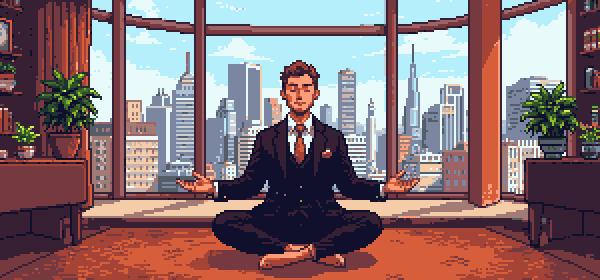Breaking the Curse of Homo Gibbosus
In today’s world, our bodies are adapting to a lifestyle that evolution never prepared us for. Hours of sitting, slouching over screens, and a lack of proper movement have given rise to what we could call Homo gibbosus—the modern human with a rounded back, weak posture, and chronic pain.
But this doesn’t have to be our fate. The human spine is designed for strength, mobility, and endurance. When we move well and train correctly, we can not only eliminate pain but also regain power, confidence, and resilience in our everyday lives.
The Key Problem: Sitting
So – sitting is the villain here. Spending hours parked in a chair kicks off a brutal chain reaction: weak glutes, tight and shortened hip flexors, and a core that checks out early. The hip flexors—often ignored—become chronically shortened, pulling on the pelvis and spine, and setting the stage for lower back pain and postural chaos.
A Vicious Cycle of Weakness and Pain
Long stretches of sitting cause the hip flexors to tighten and shorten. Meanwhile, the glutes—especially the stabilizing gluteus medius—grow lazy and weak, failing to keep the pelvis and spine properly aligned. The spine compensates by rounding forward, dragging you into that classic hunch. The erector spinae muscles become cramped, locked-tight, and ironically, weak from underuse. Over time, these dysfunctional movement patterns make even standing and walking inefficient and painful.
This cycle can be broken down into:
- Hip flexors tighten and shorten
- Gluteus medius and other glutes weaken and fail to stabilize
- Pelvis loses neutral position and tilts
- Spine rounds to compensate
- Erector spinae muscles become tight yet weak
- Movement efficiency and posture degrade further
Two Tribes of Office Apes
Most of us are Slouchers—the majority sinking into posterior pelvic tilt, slumped thoracic spines, and forward head posture. But there’s a smaller crew: the Upright Grinders. These folks fight slouching by sitting or standing ramrod straight with anterior pelvic tilt and overarched lower backs. Their hip flexors are tight, their necks jut forward just as badly, but they mask the problem with tension and rigidity instead of collapse.
The Forgotten Curve – Enter: Nerd Neck
Another widespread side effect of screen-based living is the so-called Nerd Neck (also known as Tech Neck). It’s what happens when your head constantly juts forward—whether you're glued to a monitor or doom-scrolling on your phone.
And no, it doesn’t stop once you get up from your chair. We’ve simply taken the desk posture with us—on the train, on the sidewalk, even while walking into traffic. Because apparently, escaping sedentary life means taking your bad posture on tour.
A Bowling Ball on a Toothpick
The average human head weighs around 5–6 kg. For every few centimeters it moves forward, the effective load on your cervical spine doubles. It’s like holding a bowling ball far in front of your chest instead of letting it rest on your shoulders.
This leads to:
- chronically tight upper traps and levator scapulae,
- overloaded neck extensors,
- a weakened deep neck flexor system (your built-in chin-tuckers),
- and often headaches, shoulder pain, or even tingling arms.
The worst part? You rarely notice it. It's a slow creep—a postural tax you're paying 24/7 without realizing it. That’s why awareness is the first step toward reserection. (pun intended) Start observing how often your chin leads the way instead of your chest.
Breaking the Sitting Habit
Addressing these issues requires a combination of awareness, habit changes, and targeted exercises. But let’s be honest: most people don’t change just because they know better—they change because something starts to hurt.
This is what I like to call Leidensdruck. That inner pressure born from discomfort, stiffness, or straight-up pain. It’s the moment when ignoring your posture costs more than fixing it. Not ideal, but incredibly effective. Pain, in that sense, is a brutally honest coach.
If you're already feeling the pinch, good. That means your body’s alarm system is working. If not, don’t wait. Awareness is still the first step toward reserection (pun absolutely intended). Start by noticing how often your chin leads instead of your chest, or how your lower back feels after an hour in the chair.
1. Alternatives to Sitting All Day
- Standing Desks & Height-Adjustable Tables – Switching between sitting and standing throughout the day helps mitigate postural damage.
- Leaning Seats – Offering a middle ground between sitting and standing, these promote better posture and core activation.
- Active Workstations – Treadmill desks or balance boards can introduce movement into an otherwise sedentary work routine.
If you need to sit, consider using a sitting ball—modern versions come with stylish upholstery and provide great support. If you prefer a regular or even an “ergonomic” chair, make an effort to sit straight from time to time without leaning back. Engage your core muscles, keep your chest lifted, and maintain good posture to support your spine and overall stability.
And don’t forget your neck! Keep your screens at eye level, take phone breaks without craning forward, and practice holding your head as if it were the crown of a wise ruler—not a turtle escaping into its shell.
2. Office Fitness is Invisible but Effective
Even if you must sit, incorporating micro-movements and targeted exercises can counteract the negative effects.
- Invisible Deadlifts – A subtle yet effective way to engage the posterior chain. Similar to a Bulgarian deadlift, but without the barbell. Keep your legs stiff, activate your back and core, and retract your shoulders. Lean forward until you feel a stretch in your hamstrings. Then, lift the “invisible” weight as if it were truly heavy.
- Standing Lateral Leg Side Raises – Strengthening the gluteus medius can improve pelvic stability and reduce back pain.
- Standing Cat-Cow (Yes - the Yoga Pose) – Just like the original, but standing. Lean forward, rest your hands on your knees, and flow through the movement—no need to worry about your business trousers.
- Toilet Seat Cycler - Or any other seat with enough space to lean back while performing single-legged crunches. Important: Never crunch with a bloated stomach.
- Squats - Just simple squats. Except squats aren’t that simple. 🥸 Do Splits If you are felling adventurous and want to get some extra stretch on the hip flexor (A bit like Warrior I)
- Y-W's - Bent knees. Bent forward. Flexed core. Ultra slow.
- Chin Tucks (aka Anti-Nerd-Neck Drill) – While sitting or standing upright – shoulders back, chest out – gently draw your chin straight back—like trying to make a double chin without lowering your head. Hold for 3–5 seconds and repeat 10–15x. This strengthens the deep cervical flexors and helps bring your head back in line with your spine. It's subtle. It looks weird. It works.
 Business Yoga is a Thing!
Business Yoga is a Thing!
3. Office Mobility and Stretching Exercises
- Warrior 1 (Yes, Again—Yoga) Hip Flexor Stretch – Helps counteract the shortening of the hip flexors.
- Standing Quadriceps Stretch – Loosens tight quads, reducing strain on the lower back and pelvis.
- Sun Salutations - Once again: Yoga! You may have noticed: I like Yoga. Remember: a minute spent with Yoga is a minute NOT sitting.
Try to welcome yoga into your whole life! Start with a simple morning routine to wake up your body and maybe keep a yoga mat in your office for a quick stretch during breaks. In the evening, unwind with a few relaxing poses to let go of the day’s tension. Let YouTube inspire you—it’s full of useful routines. Just make sure nothing hurts, and remember: consistency is key.
What better Time than NOW
Your body was made to move. By breaking free from the constraints of the modern workspace, incorporating better habits, and strengthening key muscles, you can reclaim your natural posture and feel stronger every day. But remember, this is a journey. The path to a healthier, pain-free life isn’t a one-time fix—it’s about consistently applying effort and progressing. When you reach a point where you feel comfortable, don’t settle; push further. Each step you take should bring you closer to a stronger version of yourself. Your training should be dynamic, always evolving, so you’re not merely maintaining a plateau but continually growing. Progression is vital—if you don’t actively strive for it, you risk falling back into old habits and undoing all your hard work.
For a deeper dive into a movement-based approach to fitness, check out my article on -> Caveman Training—a philosophy that embraces natural, functional movements to build strength and resilience. It’s a great starting point, but don’t stop there—evolving your routine, pushing yourself to new limits, and adapting to your changing physical capabilities are essential for long-term success.
The Danger of Unsupervised Training
While it's crucial to take action and improve your fitness, it’s also important to approach training with caution. Exercising without proper supervision, guidance, or care can lead to injuries that not only hinder your progress but may also cause long-term damage. Whether you’re lifting weights, stretching, or attempting new movements, always ensure you're using proper technique and, if possible, seek professional advice when starting or altering your routine. Overestimating your abilities or neglecting proper form can result in muscle strains, joint pain, and even more severe injuries. Always listen to your body and prioritize safety over pushing too hard, too fast. Your body is resilient, but it’s important to respect its limits to ensure you’re building strength safely and effectively. Building a foundation of proper technique will help prevent injuries and support long-term progress.

